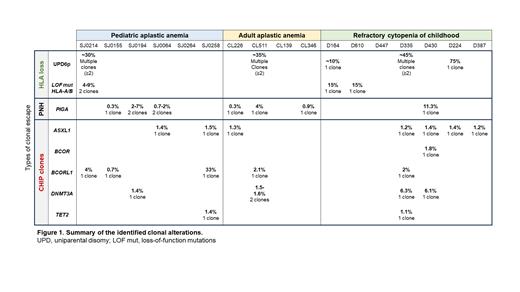Acquired aplastic anemia (AA) is a bone marrow failure resulting from an autoimmune T-cell attack against hematopoietic stem and progenitor cells (HSPCs). Several escape mechanisms within the HSPC compartment have been reported: i) adaptive alterations causing loss of high-risk HLA allele of AA development [deletion or uniparental disomy (UPD) of chromosome 6p including HLA cluster region, and loss-of-function (LOF) mutations in HLA gene], ii) clonal expansion of paroxysmal nocturnal hemoglobinuria (PNH) clone resulting from PIGA mutation, and iii) presence of clonal hematopoiesis of indeterminate potential (CHIP) mutations (i.e., BCOR/ BCORL1, DNMT3A, ASXL1). Multiple types of alterations often co-occur, however due to the inherent limitations of conventional methods, it is not known if i) these alterations are in the same or independent clones, ii) what is the mutational hierarchy, and iii) what is the cell of origin. We addressed these questions using single-cell and bulk genomic sequencing.
We developed custom single-cell panels covering HLA class I and II genes, along with 14 genes commonly mutated in AA and myelodysplastic syndromes. To identify copy number variations and UPD, we included 197 single nucleotide variants (SNVs) frequent across all ethnic backgrounds on chromosomes 6, 7, 8, 20, and 21. The TotalSeq™-D panel (BioLegend), was included to target 42 surface antigens and the samples were prepared on the Tapestri platform (Missionbio). High-resolution HLA genotyping was done using AlloSeq Tx 17 hybrid capture NGS assay (CareDx), and for confirmatory bulk sequencing we applied a custom duplex UMI NGS panel (TWIST Bioscience).
We examined ten patients with severe AA (pediatric: n=6, age range 2-15 years; adult: n=4, 26-67), seven patients with refractory cytopenia of childhood (RCC, age range 2-16 years), who presented a hypocellular marrow and absence of a genetic predisposition syndrome, and one healthy control. All 17 patients had at least one of the HLA-A or HLA-B risk alleles linked to AA development. A total of 136,505 cells (median 4,467/run) were successfully genotyped across the samples. Single-cell trajectory analysis revealed that all identified clones arose independent of each other (Figure 1). UPD6p clones were found in five patients with three having multiple UPD6p clones carrying different breakpoints, pointing to clonal diversification. Additionally, three cases had LOF mutations in HLA-A or HLA-B (two having coexisting UPD6p). In a patient with two UPD6p and two HLA-A mutant clones, we verified that HLA-A risk allele (A*02:01) was lost in each instance. Multi-omic analysis revealed that these clones had both granulocytic and non-granulocytic (incl. lymphocytic) surface phenotypes, suggesting their early origin within hematopoietic ontogeny. Seven patients had nine independent clones with PIGA mutations (0.3-11.3% of the cells), consistent with its tendency to generate clonal mosaicism. Clones with mutations in BCOR/BCORL1, ASXL1, DNMT3A, and TET2 were identified in six, seven, four, and two patients, respectively. We next analyzed how many patients carry multiple clones and found that 65% (11/17) have concomitant clones, with the majority (9/11) belonging to different types of clonal escape (Figure 1). Finally, we found that 4/6 patients with adaptive HLA loss (representing true clonal escape from T-cell autoimmunity) also carried CHIP clones, indicating that adaptive hematopoiesis does not protect from the acquisition of CHIP mutations.
In conclusion, we show that patients with AA across age spectrum and some patients with RCC share similar clonal backgrounds, with multiple functionally redundant alterations arising independently from coexisting CHIP clones. For the first time at a single-cell level, we were able to resolve the multifaceted clonal mosaic generated by the immunological forces at play in AA, and precisely unravel their immunoediting consequences.
Disclosures
Maciejewski:Regeneron: Consultancy, Honoraria; Novartis: Honoraria, Speakers Bureau; Alexion: Membership on an entity's Board of Directors or advisory committees; Omeros: Consultancy. Niemeyer:Apriligen: Honoraria, Other: Advisory Role, Expert Testimony ; BMS: Honoraria, Other: Advisory Role, Expert Testimony; Novartis: Other: Advisory Role. Wlodarski:Novartis: Honoraria.


This feature is available to Subscribers Only
Sign In or Create an Account Close Modal